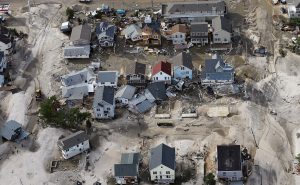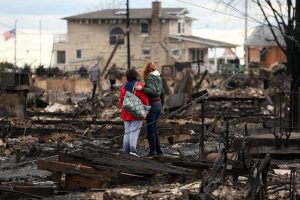[perfectpullquote align=”full” bordertop=”false” cite=”” link=”” color=”” class=”” size=””]What are the effects of climate change that impact mental health?[/perfectpullquote]

Photos, like the ones of polar bears on melting ice caps and forests burning, have become synonymous with the climate crisis. Though intended to create a sense of urgency and evoke strong emotion, this alarmist imagery and language can actually inhibit action, paralyzing people with fear and a sense of hopelessness.
Exposure to negative and fatalistic climate news can create stress, anxiety, and grief.
People do not have to live through a natural disaster to suffer the mental health consequences of climate change. Media in particular has a strong influence on perceptions of climate change. For decades, the media has used images of doom to represent climate change. Watching or reading about climate change and natural disasters can cause anxiety, depression, secondary trauma, and other psychological conditions.
The physical impacts of climate change will have direct impact on our lifestyles as well as society’s wider infrastructure.
As global temperatures rise, warmer temperatures and water contribute to

- Sea Level Rise: Sea level rise is the result of added water from melting glaciers and polar ice sheets and the expansion of
seawater as it warms. The global sea level has risen by about 7.7 inches in the last 140 years and is projected to rise another 1 to 8 feet by 2100. - Extreme Weather: Warmer air temperatures increase the likelihood of severe weather events. Regions around the world are experiencing more precipitation, which leads to increased flooding. In addition, the intensity, frequency, and duration of hurricanes and superstorms have also increased. Extreme heat events have also become more common, increasing the risks of wildfire, drought and disease.
These impacts lead to:

- The damage and destruction of homes, property, and livelihoods. People are also at risk of illness, injury, and death.
- The disruption of essential infrastructures. Extreme temperatures and weather, sea level rise, and disasters cause the breakdown of transportation, communication, medical, power, and waste management systems. Changes in precipitation, droughts, storms, and sea level rise will also contribute to food and water insecurity. Disruptions of one infrastructure will almost always result in disruptions in one or more other infrastructures. Without these infrastructures, society loses access to critical resources
- Climate migration and displacement. With homes, livelihoods, and resources lost and threats increasing, many people choose or are forced to migrate to new areas within their country or across borders. In doing so, they leave behind social networks, cultural heritage, and a sense of place that provide important practical and emotional resources associated with health and well-being. Climate change is expected to displace more than 200 million people by 2050.
